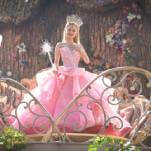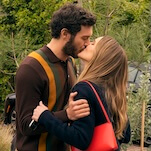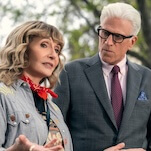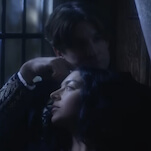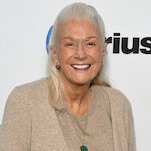Ashley Nell Tipton both changed and confirmed Project Runway’s ideas about plus-size fashion
Image: Graphic: Natalie Peeples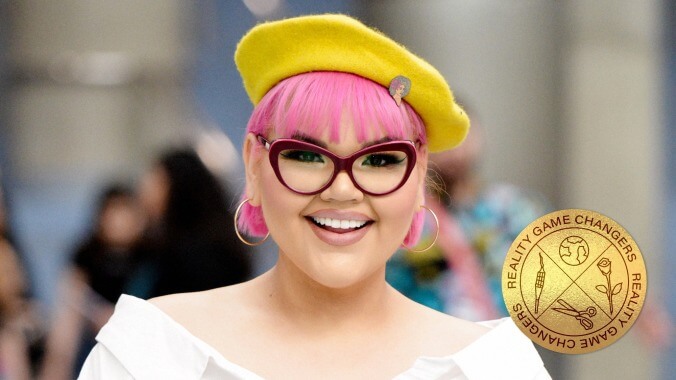

If you’ve never had to descend into the basement of a store, go behind the cash register and through the maternity section, only to find a single rack of blousy oversized tunics, then maybe Project Runway featuring plus-sized clothing isn’t that big of a deal for you. It certainly doesn’t seem to be important to many of the contestants: Over the reality competition show’s 19 seasons, more designers have been visibly displeased about having to dress non-sample sized women (i.e., above a size 4) than have specialized in catering to them. Who could forget season 10’s Ven, who kept insisting that the size 14 woman he was paired with in a makeover challenge had “no shape” and “no style,” treating her so badly that started crying in the workroom?
So what’s the problem? At risk of oversimplifying the issue, the excuses you hear most often about why designers “don’t do” plus sizes are these: That “curvy” women are harder to fit, and that the cost of fabric makes manufacturing bigger sizes less cost effective. “Harder” is debatable, but there is skill involved in tailoring clothes for different body types and sizes—techniques many fashion students don’t bother to learn, as becomes obvious hearing the groans from the designers when a Project Runway judge announces that this week will be a “real women” challenge. Because of this, and because most plus-sized shopping is still done online, one area where plus fashion still lags behind its “straight sized” counterparts is in the area of smart, tailored separates. No, it’s all elastic waists, billowy cuts, and so much jersey fabric, which is why Ashley Nell Tipton’s season 14 victory was something of a mixed bag.
Given that season four winner (and current mentor) Christian Siriano was a pioneer in the realm of inclusive dressing, it’s remarkable that it took the show so long to crown a plus-sized specialist as the winner. Beginning with season 16, designers have had no choice but to dress models going up to a runway 22, and those who don’t have the range have gone home for it. That was emphatically not the case in season 14, and Tipton worked with “sample size” models all season before bringing in plus models for her finale runway show. In an inversion of the usual dynamic, she talked about having to adjust her methods for smaller sizes in a 2015 interview with Wear Your Voice:
“I have to remember that I learned how to do “straight sizes” in school, and that’s what we practiced, and learning everything about “plus size” has been from a few teachers and myself. I don’t feel like it’s harder in any way to design for “straight sizes,” I almost feel like it’s a little easier and you have more freedom to do some things, but when it comes to plus sizes, I enjoy doing it so much that it’s not a problem. I prefer to do it, and I have fun with it.”
Tipton’s comments on teaching herself how to design clothes for plus sizes track: When you can’t find the thing you’re looking for in a store, one alternative is to learn to make it yourself. And Tipton’s origins—she learned how to sew from her grandmother at age 7—are reflected in her finale collection. Inspired by the fashions of 1950s Mexico City and her own Mexican-American heritage, Tipton’s 10-piece runway show was heavy on sheer fabrics and feminine silhouettes topped with handmade flower crowns. The color palette of dusky purple, peach, and turquoise was exquisitely romantic, and matched Tipton’s lavender hair besides.
There’s always a tension between innovation and mainstream appeal on Project Runway, and Tipton’s finale collection was certainly wearable—so much so, she signed a contract with JCPenney shortly afterwards. Like her Project Runway collection, Tipton’s JCPenney designs revolve around crop tops, bodysuits, sheer florals, and flowing cover-ups, all staples of plus-sized fashion that are forgiving in fit and easy to manufacture on a large scale. But although it’s no fault of Tipton’s—she has a strong personal aesthetic, and designs clothes people like to wear—the fact that Project Runway’s first plus-sized winner makes items that are so, well, commercial speaks to lowered expectations around polish for plus-sized consumers. Is this actually what larger women want to wear, or is it what the judges assume larger women want to wear?
In a 2016 Washington Post editorial excoriating the fashion industry for its inability to rise to the challenge of dressing plus-sized consumers, then-mentor Tim Gunn called Tipton’s winning collection “hideous” and the judges’ praise for it “condescending.” “One judge told me that she was ‘voting for the symbol’ and that these were clothes for a ‘certain population,’” he wrote. (Gunn, for his part, likes those tailored separates that keep coming up.) Gunn’s insinuation that the first plus-sized winner of Project Runway was, in essence, a pity vote is disappointing; you don’t want to believe it, but it’s plausible, putting Heidi Klum, Nina García, and Zac Posen into the role of a patronizing stranger saying you’re “so brave” for wearing a tank top in public. (Significantly, the word “brave” also came up in Tipton’s final critique.) In interviews, Tipton has said that Gunn’s criticisms are the only ones that really hurt her, telling Buzzfeed, “we really fought for what we did, and we really wanted this so much. I don’t know what to say, because it’s kind of shocking to hear [what he said].”
But even if you’re ambivalent about Ashley Nell Tipton’s clothes, the urge to defend her is strong. The dynamic between Tipton and her fellow Project Runway designers, who picked her last for team challenges and dismissed her abilities in confessional interviews, replicated the rejection many larger people experience as children. As she told Refinery 29, “It’s just like high school; they never wanted to sit with me—nothing. At that point, I realized I wasn’t there to make everyone like me.” Watching her assert her worth—both as a designer and as a person—made Tipton a sympathetic figure for plus-sized viewers. But even this is fraught: Tipton opted to undergo gastric bypass surgery in 2017, shocking some fans who felt she had betrayed the cause. At the time, body positive blogger Ash wrote, “To be clear, Ashley Nell Tipton doesn’t owe it to us to remain fat. But it does hurt a little when we lose another fat hero.”
People’s relationships with their bodies are highly personal and emotionally charged, no matter their weight. Maybe that’s why it’s so complicated with Ashley Nell Tipton—one person’s clothes can’t fix a systemic problem, nor can they appeal to every member of a demographic that makes up 68% of U.S. women as of 2018. Her Project Runway victory was at both a huge step forward and—again, through no fault of her own—a doubling down on industry assumptions about what “good design” means for larger bodies. Hopefully, this conversation will continue and new opportunities will open up, so that in the future no one person will have to shoulder the dreams and insecurities of so many others the way Tipton had to. For the record, though, the flower crowns were cute.
GET A.V.CLUB RIGHT IN YOUR INBOX
Pop culture obsessives writing for the pop culture obsessed.





